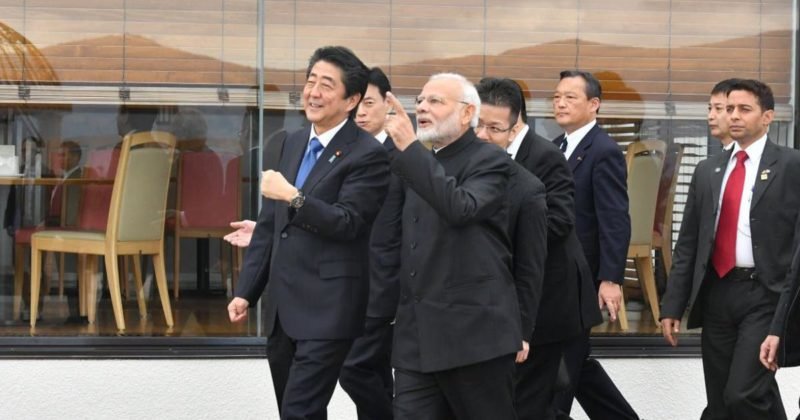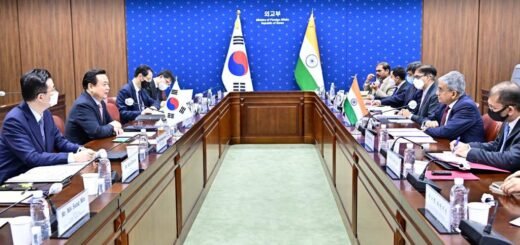Brighter Prospects of Japan-India Relations in Modi 2.0

Today, although India and Japan are collaborating in areas as diverse as space research and agriculture, this deep bilateral engagement has been built brick by brick on the base of a long and historically close bilateral relationship and the delivery of tangible projects. Japanese Prime Minister Shinzo Abe was the first foreign dignitary to congratulate Prime Minister Narendra Modi on his resounding victory in the parliamentary elections on 23 May 2019. Their telephonic conversation confirmed their determination to continue to strengthen the bilateral ties and take them to the next level in the coming years. Since both leaders have a fairly long tenure before them — with Modi’s fresh tenure of five years and Abe’s tenure until September 2021, they can work out on a new road map for further advancing the partnership. Since both of them have been working together since 2014, they enjoy the advantage of ‘continuity’ and can go ahead smoothly to implement many ambitious infrastructure projects already in the pipeline and also make new initiatives to further widen their engagements.
Sound Politico-Strategic Relations

The people of India and Japan are guided by common cultural traditions including the heritage of Buddhism and share a strong commitment to the ideals of democracy, tolerance, pluralism and open societies. India and Japan, two of the largest and oldest democracies in Asia, having a high degree of congruence of political, economic and strategic interests, view each other as partners that have responsibility for, and are capable of, responding to global and regional challenges. The return of Modi to power for one more tenure has been welcomed by analysts in both India and Japan as far as Indo-Japanese relations are concerned. They believe that though there has been a great deal of debate on some of the policy decisions of Modi on the domestic economy, there is a broad national consensus on many aspects of Modi’s foreign policy. In particular, nobody can dispute that bilateral relations between India and Japan have progressed in all directions during 2014-2019. Modi’s first term coincided with Abe’s administration in Japan and since 2012, Abe had consolidated his position by his efforts to revamp the country’s economy by pursuing a three-pronged strategy called Abenomics. He also embarked on vigorous diplomacy that sought to redefine Japan’s role in the Indo-Pacific region. When PM Modi himself launched his ‘Act East policy’ soon after coming to power in 2014, their interests were converging on a range of strategic issues like maritime security, energy cooperation, regional cooperation and integration. Soon they developed a strong personal chemistry. Modi also believed that Japan, a technological powerhouse with immense financial strength, could fulfil India’s development needs in several spheres including infrastructure.
In the context, the foundation stone of a strong relationship between India and Japan was laid down when Japanese Prime Minister Yoshiro Mori visited India in August 2000 and provided the momentum to strengthen the Japan-India relationship. In course of the visit, Mori and Indian Prime Minister Atal Bihari Vajpayee decided the establishment of “Global Partnership between Japan and India”. Since Prime Minister Junichiro Koizumi’s visit to India in April 2005, Japan-India annual summit meetings have been held in respective capitals. When Prime Minister Manmohan Singh visited Japan in December 2006, the Japan-India relationship was elevated to the “Global and Strategic Partnership”. In September 2014, Prime Minister Narendra Modi paid an official visit to Japan and had a summit meeting with Prime Minister Shinzo Abe. They agreed that the Japan-India relationship was upgraded to “Special Strategic and Global Partnership.” In December 2015, Prime Minister Abe paid an official visit to India and had a summit meeting with Prime Minister Narendra Modi. The two Prime Ministers resolved to transform the Japan-India Special Strategic and Global Partnership into a deep, broad-based and action-oriented partnership, which reflects a broad convergence of their long-term political, economic and strategic goals. They announced “Japan and India Vision 2025 Special Strategic and Global Partnership Working Together for Peace and Prosperity of the Indo-Pacific Region and the World”. The joint statement heralded the event as a guidepost for the “new era in Japan-India relations.”
In response to Abe’s India visit, in November 2016, Prime Minister Modi paid an official visit to Japan and had a summit meeting with his Japanese counterpart. Prime Minister Abe stated that this summit meeting was a magnificent meeting that substantially advanced the “new era in Japan-India relations,” and he hoped the two countries would lead the prosperity and stability of the Indo-Pacific region as a result of coordinating the “Free and Open India and Pacific Strategy” and the “Act East” policy.
Mutual Economic Relations
Despite the increasing salience of the strategic factor, economic cooperation will continue to be the bedrock of India-Japan relations. Modi has succeeded in getting Japan involved in many important mega-infrastructure projects in India and this will continue during his second term too. Modi has always insisted that Japan has done much more for India’s modernisation than any other country and that Japan’s technological and economic strength could accelerate India’s development by transforming its infrastructure and manufacturing sectors. He took the decision to set up a number of Japanese industrial townships and electronic parks for developing technology, and inspiring innovation.
During 2014-19, the quality and quantity of Japan’s official development assistance (ODA) witnessed remarkable strides and India has been the biggest recipient of Japan’s aid for several years now. Though Japan’s private investment has also increased during these years, it has not lived up to its potential. With a cumulative FDI of $ 25.2 billion during 2000-17, Japan is the third-largest investor in India accounting for 8% of India’s total FDI.
Joint Security Preparedness
Having elevated the bilateral ties to a special strategic and global partnership in 2014, both Modi and Abe have sought to make it a major element for peace and stability in the Indo-Pacific region. Now Modi 2.0 will provide new opportunities to take the partnership to its logical conclusion. Emphasizing the need for closer coordination between the two countries to address regional security, Modi has supported robust defence cooperation with Japan. Such cooperation has been expanding in recent years supported by the regular annual Strategic Dialogue and the Defence Dialogue between the two. Further, in 2018, both Modi and Abe agreed to create a new Foreign and Defence Ministerial Dialogue to further intensify defence cooperation. Modi has also elevated the US-Japan-India trilateral dialogue to the ministerial level. In addition, meetings between India, Japan, the US and Australia under the Quad format have been institutionalised. Stressing the need to intensify defence cooperation, both countries signed a memorandum of defence cooperation followed by two more accords on the transfer of defence equipment and technology and protection of classified military information. They are also engaged in discussions on the possibilities of India acquiring Japanese technology in the production of submarines and on cooperative research in areas like unmanned Ground Vehicle and Robotics. These discussions will be most certainly pursued with greater vigour from now on. With both Japan and India have adopted flexible policies on the flow of defence technology, there is a win-win situation for both countries to cooperate in defence production. There is also a strong likelihood of both India and Japan clinching a military logistics sharing agreement that would enable both countries to have access to each other’s military bases. In this context, it is important to note that both Modi and Abe succeeded in signing a landmark agreement on the civil nuclear cooperation in 2016 after prolonged negotiations. In his new tenure, Modi will turn his attention to the operationalization of the agreement.

Cooperation in maritime security is another subject that would receive Modi’s attention in the coming years. Sharing convergent interests, both countries are strongly committed to freedom of navigation and overflights and unimpeded commerce in the open sea. As for their bilateral maritime cooperation, both their navies are conducting annual exercises. Additionally, Modi has been responsible for Japan’s participation in the annual India-US Malabar naval exercises on a regular basis. Now the three countries conduct joint exercises in all three wings of the defence forces.
With Modi’s return to power, Japan’s involvement in infrastructure projects, particularly in Northeast India, will further deepen and contribute to closer links with Southeast Asian countries. Similarly, one can also hope to see a smooth implementation of the prestigious high-speed rail project linking Ahmedabad and Mumbai. Finally, both Modi and Abe will have adequate time to take measures to implement their Asia-Africa Growth Corridor (AAGC) project. One important objective of the project is to bring about greater integration within the Indo-Pacific region by undertaking several infrastructure projects.


















